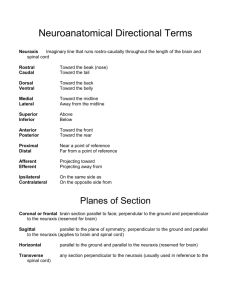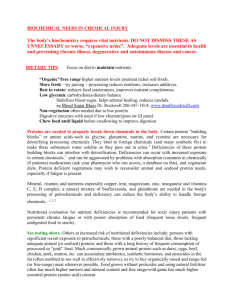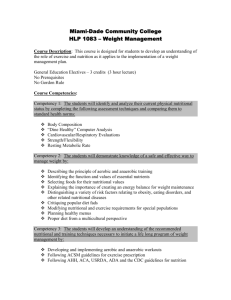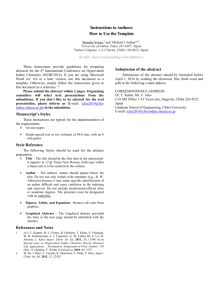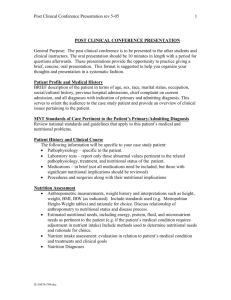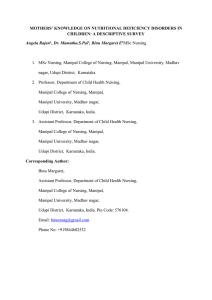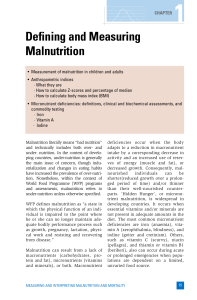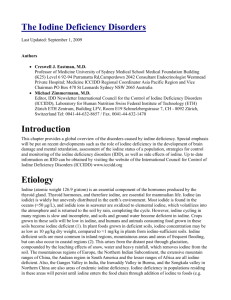Spring 2011 Newsletter
advertisement
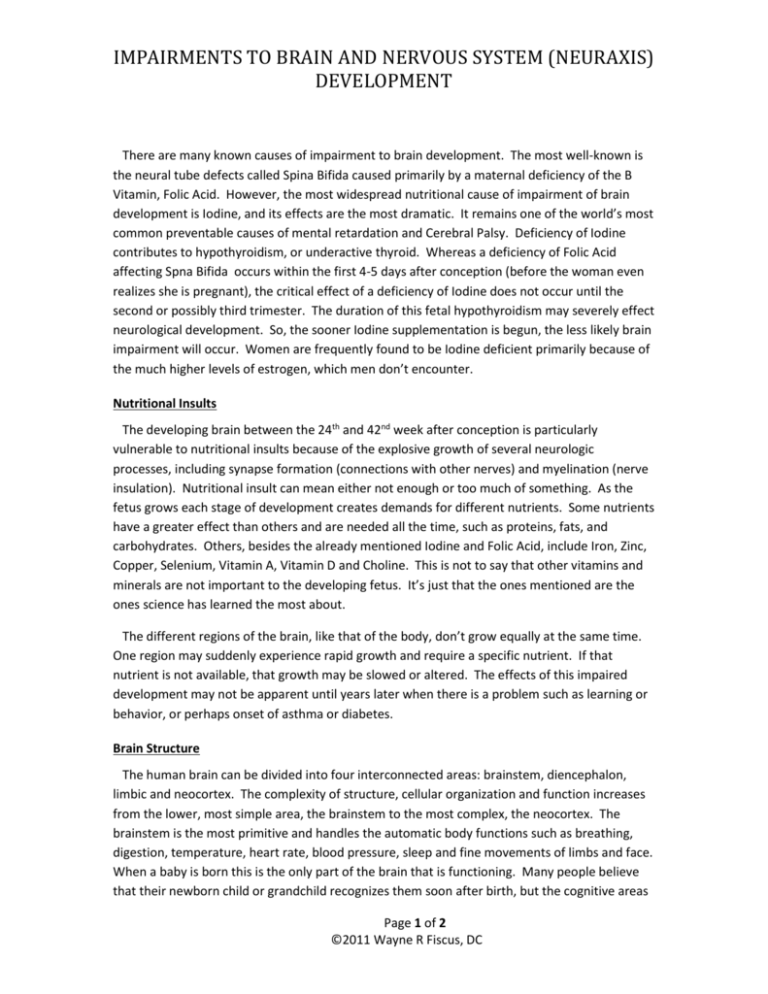
IMPAIRMENTS TO BRAIN AND NERVOUS SYSTEM (NEURAXIS) DEVELOPMENT There are many known causes of impairment to brain development. The most well-known is the neural tube defects called Spina Bifida caused primarily by a maternal deficiency of the B Vitamin, Folic Acid. However, the most widespread nutritional cause of impairment of brain development is Iodine, and its effects are the most dramatic. It remains one of the world’s most common preventable causes of mental retardation and Cerebral Palsy. Deficiency of Iodine contributes to hypothyroidism, or underactive thyroid. Whereas a deficiency of Folic Acid affecting Spna Bifida occurs within the first 4-5 days after conception (before the woman even realizes she is pregnant), the critical effect of a deficiency of Iodine does not occur until the second or possibly third trimester. The duration of this fetal hypothyroidism may severely effect neurological development. So, the sooner Iodine supplementation is begun, the less likely brain impairment will occur. Women are frequently found to be Iodine deficient primarily because of the much higher levels of estrogen, which men don’t encounter. Nutritional Insults The developing brain between the 24th and 42nd week after conception is particularly vulnerable to nutritional insults because of the explosive growth of several neurologic processes, including synapse formation (connections with other nerves) and myelination (nerve insulation). Nutritional insult can mean either not enough or too much of something. As the fetus grows each stage of development creates demands for different nutrients. Some nutrients have a greater effect than others and are needed all the time, such as proteins, fats, and carbohydrates. Others, besides the already mentioned Iodine and Folic Acid, include Iron, Zinc, Copper, Selenium, Vitamin A, Vitamin D and Choline. This is not to say that other vitamins and minerals are not important to the developing fetus. It’s just that the ones mentioned are the ones science has learned the most about. The different regions of the brain, like that of the body, don’t grow equally at the same time. One region may suddenly experience rapid growth and require a specific nutrient. If that nutrient is not available, that growth may be slowed or altered. The effects of this impaired development may not be apparent until years later when there is a problem such as learning or behavior, or perhaps onset of asthma or diabetes. Brain Structure The human brain can be divided into four interconnected areas: brainstem, diencephalon, limbic and neocortex. The complexity of structure, cellular organization and function increases from the lower, most simple area, the brainstem to the most complex, the neocortex. The brainstem is the most primitive and handles the automatic body functions such as breathing, digestion, temperature, heart rate, blood pressure, sleep and fine movements of limbs and face. When a baby is born this is the only part of the brain that is functioning. Many people believe that their newborn child or grandchild recognizes them soon after birth, but the cognitive areas Page 1 of 2 ©2011 Wayne R Fiscus, DC IMPAIRMENTS TO BRAIN AND NERVOUS SYSTEM (NEURAXIS) DEVELOPMENT have yet to be developed. At birth all the levels of the brain are there, but it’s like a high-rise building with the upper floors unoccupied. Only the bottom floor is doing any business. The next level to develop is the diencephalon, which is the thalamus and hypothalamus. This is like a switching center that relays messages from the spinal cord and brainstem to higher levels of the brain. It controls other automatic functions such as hunger, thirst, temperature; plus contributes to perception, attention, alertness and awareness. All sensory information, except the sense of smell, must pass through this area before going to the higher levels. As this area increases the connections between nerves, the baby becomes more aware of its surroundings and the five senses become sharpened. Next up is the limbic system. This is a group of brain structures that are involved in processing and regulating emotions, memory and sexual arousal. It is an important part of the body’s response to stress and is a mediator between the hormonal system and the nervous system. It is also the center that processes the body’s response to odor. At the highest level we have the neocortex. This level consists of several areas concerned with hearing, vision, speech and those executive functions of thinking, planning and problem solving. These higher intellectual capabilities are the ones missing in the Neanderthal man as they came later in the evolutionary process. Ability to Change All these levels of the brain continue to grow and develop as the child grows to adulthood. An important consideration about the brain and nervous system is the characteristic called ‘plasticity’. This means that the neuraxis (brain and nervous system) has the ability to change if a part of it is damaged or impaired due to insult of some type. That insult could be from trauma, nutritional deficiency, radiation, genetic error, toxins, etc. This characteristic is fundamental for survival as it allows the brain to adapt. For instance, let’s say that during gestation the fetus is deprived of an important nutrient that will later effect how the child behaves. By introducing that nutrient, even years later, the brain can re-establish the normal pathways that will bring about the desired behavior. Just as brain cells that have been deprived of optimum oxygen; don’t simply die, they become dormant. When adequate oxygen is available, they can function again, even after years. Optimize Function Optimizing the function of the neuraxis by natural means is the primary goal of a chiropractic physician. This is achieved not only by spinal and cranial adjustments, but also through balancing the body chemistry by means of nutritional supplements. That part must begin even before there is a spine to adjust and preferably before conception, by having the mother balanced chemically, physically and emotionally. Page 2 of 2 ©2011 Wayne R Fiscus, DC

